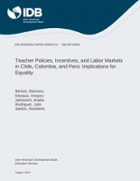Teacher Policies, Incentives, and Labor Markets in Chile, Colombia, and Peru: Implications for Equality
Date
Aug 2018
This paper contributes to the teacher sorting literature by analyzing equity in the distribution of teachers in three educational systems in Latin America, with different equalization policies, teacher assignment rules, and incentives to work in disadvantaged schools: Chile, Colombia, and Peru. We use unique micro-data at the teacher and school level to describe the distribution of teachers across the three systems. Two main conclusions emerge from our results. First, we find that differences in the sources of funding and teacher salaries legislation can affect the equity in teacher allocation between administrative units. Second, we find substantial teacher sorting across schools (vertical inequities) in the three systems. Overall, the comparison of the three countries confirms that, after controlling for confounding variables, disadvantaged students, particularly those in rural areas, are more likely to attend schools with teachers who are less qualified (temporary and inexperienced) and paid less. One of the most consistent findings in this analysis are the vertical inequities across the three measures in Colombia. In contrast, in Chile, the three measures have an inconsistent and weak relationship with mother’s level of schooling and a moderate relationship with the geographic location of the school (rural). While our analyses are descriptive and do not attempt to identify the underlying causes of these patterns, we suggest that these differences are related to the salary structure and hiring policies in the three countries. We discuss some policy alternatives to increase equity, including the introduction of monetary and non-monetary incentives to attract teachers to hard-to-staff schools, improving the working conditions and modifications in the teacher hiring and assignment process.




